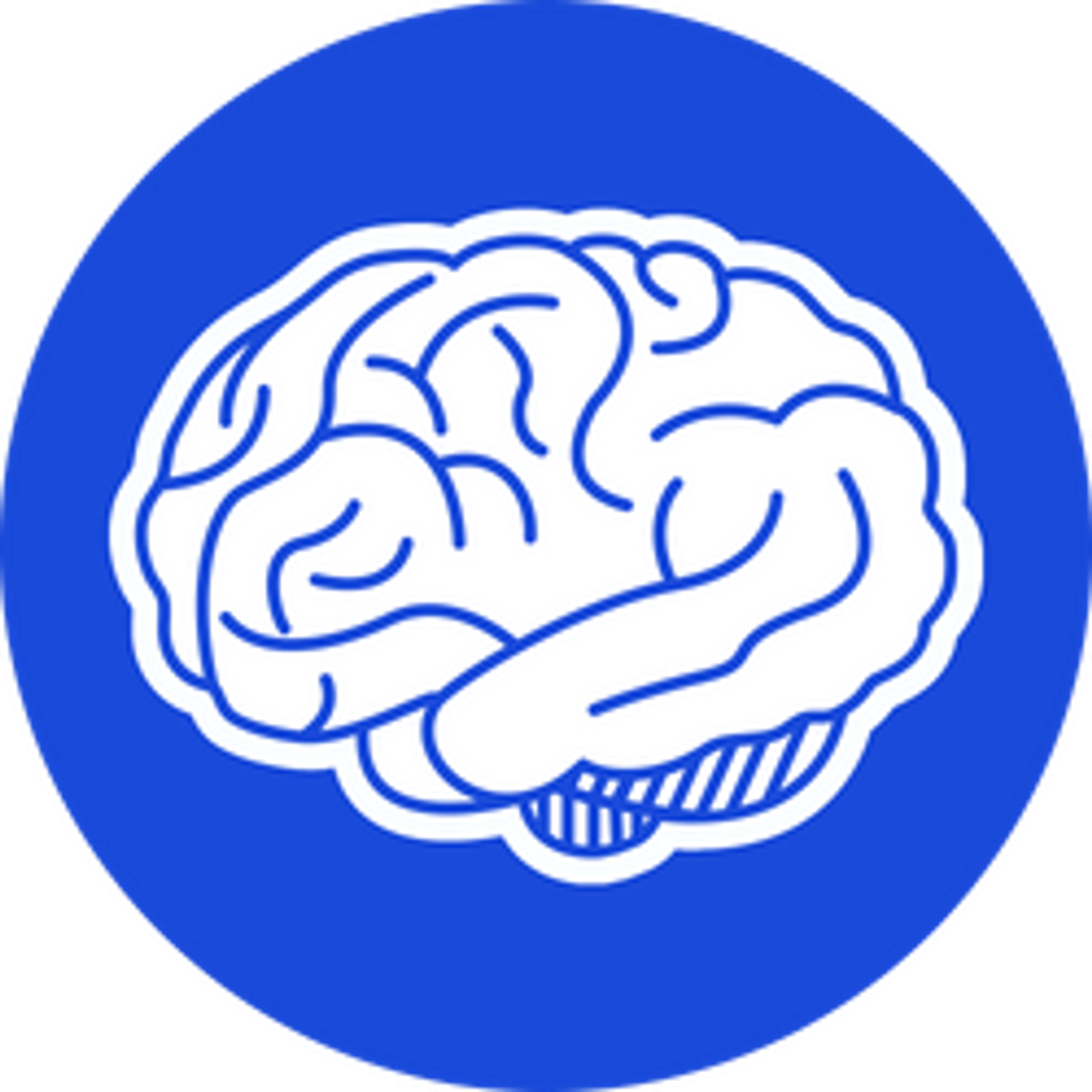Slug
febrile-seizure
Video
Category
Epilepsy
Excerpt
Children between the ages of 6 months and 5 years are at risk of febrile seizures. A fever with a temperature of 38C (104F) or greater typically precedes febrile seizures. It is possible for children with febrile seizures to be healthy, develop normally, and have no neurological symptoms. As in this article, we examine the interprofessional role in managing febrile seizures and review the pathophysiology of these conditions.
Authors
Tags
Featured
Featured
Ready to Publish
Ready to Publish
Publish Date
Nov 17, 2022
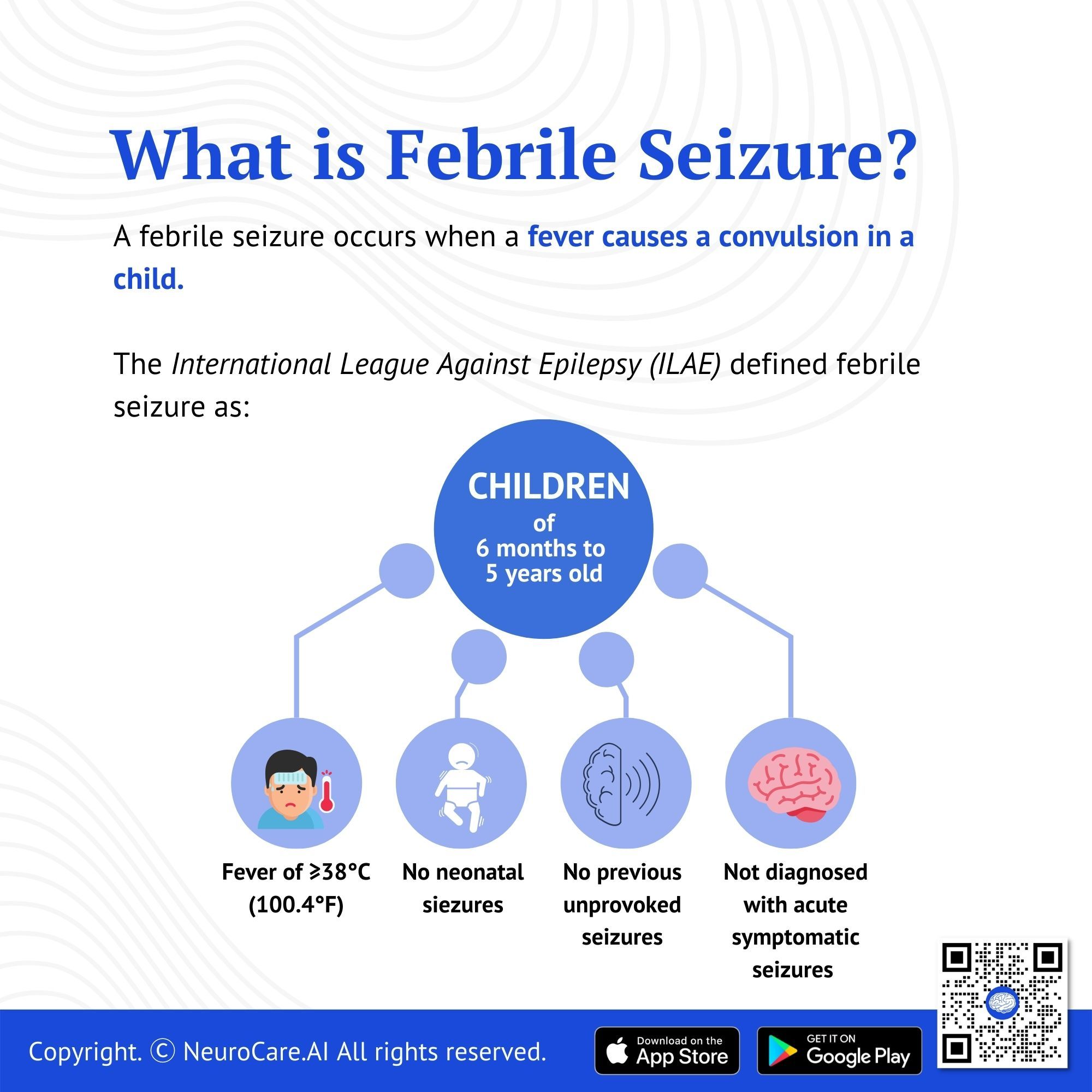
Introduction
A febrile seizure occurs when a fever causes a convulsion in a child. An infection often causes this. Children with febrile seizures can be healthy, have normal development, and have never had neurological symptoms. Although febrile seizures can be frightening, you can prepare for the basics and understand febrile seizures better.
Febrile seizures, also known as febrile convulsions, are defined by the International League Against Epilepsy (ILAE) as occurring during childhood between the ages of 6 months to 5 years and are closely related to a febrile illness. Febrile seizures usually occur with a fever ranging from 38°C (100.4°F) or even higher, there are no neonatal seizures or previous unprovoked seizures, and it does not meet the diagnosis of other acute symptomatic seizures. Most febrile seizures last less than 5 minutes. After a seizure, the child might be confused or sleepy for a short time.
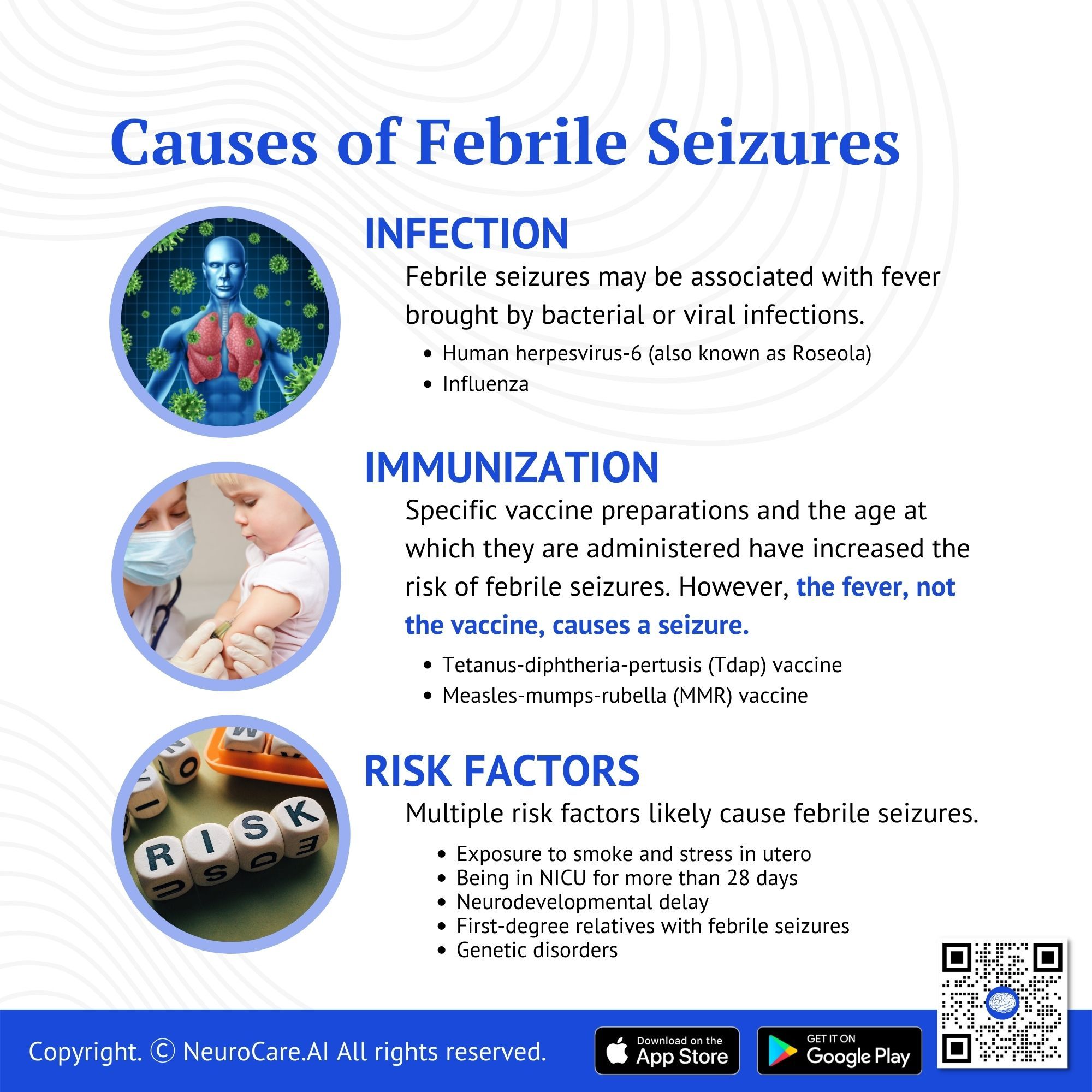
Etiology
Infection
A fever that triggers febrile seizures is primarily caused by viral infections and is less often caused by a bacterial infections. Viruses causing the flu (influenza) and roseola (human herpes virus-6), accompanied by high fevers, are most frequently associated with febrile seizures.
HHV-6 is most frequently found in the U.S. and Europe that causes febrile seizures and the Influenza A virus in most Asian countries.
Immunizations
Specific vaccine preparations and the age at which they are administered have increased the risk of febrile seizures. Tetanus-diphtheria-pertussis and measles-mumps-rubella vaccines are among these vaccines. Children may experience a low-grade fever after they have received a vaccine. However, the fever, not the vaccine, causes a seizure.
Fever usually develops 8 to 14 days after the injection. The Centers for Disease Control and Prevention (CDC) recommend immunizing MMR vaccines between 12 and 15 months of age to minimize the risk of measles-containing vaccines causing seizures.
There is a high febrile seizure risk following the influenza vaccine or the modern acellular pertussis vaccine. There are more severe consequences of preventable infections and the need to maintain herd immunity than any potential complications from vaccinations. Thus, all children should receive routine vaccinations.
Risk factors
Multiple factors likely cause febrile seizures that may harm a vulnerable nervous system under the stress of a fever. The risk factors include:
- Exposure to smoke and stress in utero
- Being in neonatal intensive care unit (NICU) for more than 28 days
- Neurodevelopmental delay
- Having first-degree relatives who have had febrile seizures
Genetic disorders increase susceptibility to environmental risk factors. Many genes shown to increase familial epilepsy syndromes also describe risk factors for febrile seizures. Temperature elevation, not the rate of temperature increase, determines the risk of febrile seizures, and the seizure threshold varies by age and individual susceptibility.
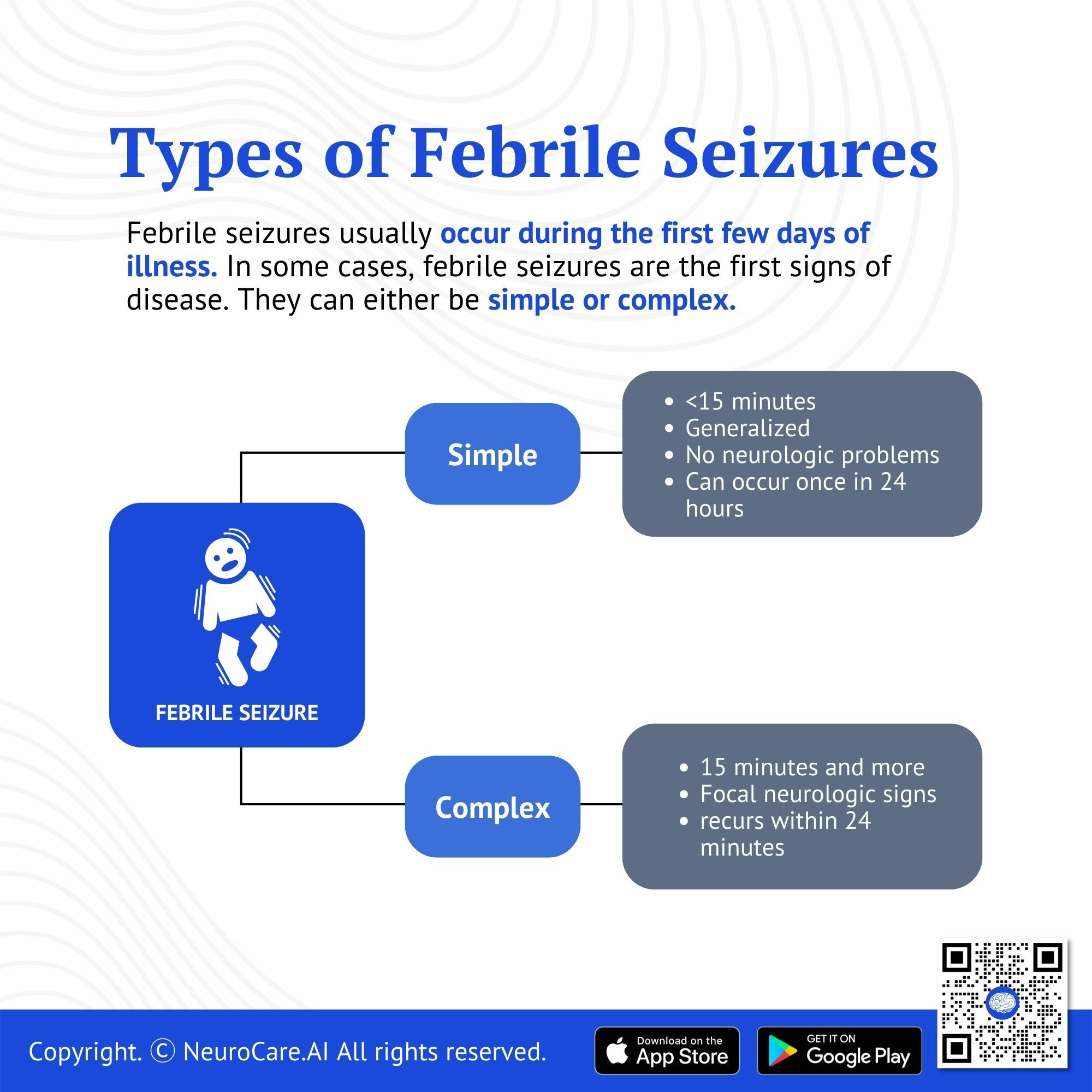
Types of febrile seizures and its symptoms
Febrile seizures usually occur during the first few days of illness. In some cases, febrile seizures are the first signs of disease. They can either be simple or complex.
The most common type of febrile seizure is a simple febrile seizure. Children often experience a convulsion or a rhythmic twitching of their arms or legs when they lose consciousness. Most seizures can last up to 1-2 minutes, although they can last up to 15 minutes. It may be that the child is confused or sleepy after the seizure, but they have no weakness in the arms or legs.
Unlike simple febrile seizures, complex febrile seizures can last up to 30 minutes (or more if they occur in series). After a seizure, the child may experience temporary weakness of an arm or leg.
Table 1. Difference between simple and complex febrile seizure
Types of Febrile Seizures | Characteristics | Symptoms |
Simple Febrile Seizure | < 15 minutes
Generalized
No neurologic problems
Can occur once in 24 hours | Roll eyes
Passing out
May vomit or peer during seizures
Convulse, shake, uncontrolled twitching
No weakness in the arms and legs |
Complex Febrile Seizure | 15 minutes and more
Focal neurologic signs
Recurs within 24 minutes | Temporary weakness in the arms and legs
|
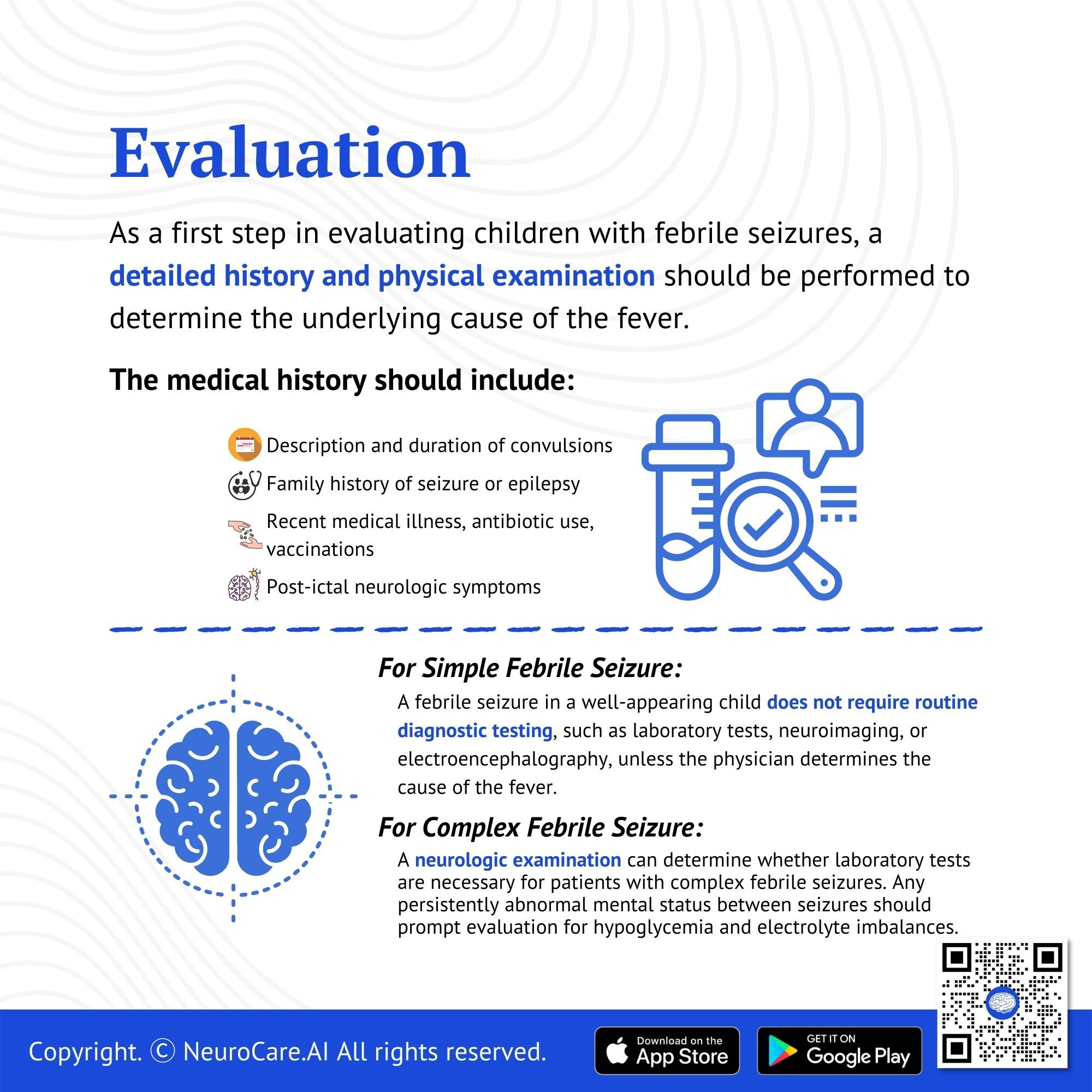
Evaluation
As a first step in evaluating children with febrile seizures, a detailed history and physical examination should be performed to determine the underlying cause of the fever. The medical history should include:
- Description and duration of the convulsions,
- Family history of seizures or epilepsy,
- Recent medical illness, antibiotic use, or recent vaccinations, and
- Post-ictal neurologic symptoms or Todd paralysis (i.e., weakness on one side of the body) can help identify the type of febrile seizure.
For Simple Febrile Seizure:
Children can develop fevers with or without seizures for similar reasons. The risks of bacterial meningitis, urinary tract infection, pneumonia, or bacteremia are not higher in children with a simple febrile seizure. A febrile seizure in a well-appearing child does not require routine diagnostic testing, such as laboratory tests, neuroimaging, or electroencephalography, unless the physician determines the cause of the fever.
For Complex Febrile Seizure:
A neurologic examination can determine whether laboratory tests are necessary for patients with complex febrile seizures. The risk of hypoglycemia is low in children with febrile seizures, and their serum sodium levels may be lower, but that does not predict seizure recurrence in well-appearing children. Any persistently abnormal mental status between seizures should prompt evaluation for hypoglycemia and electrolyte imbalances.
An early evaluation of a child experiencing a febrile seizure by a health professional is crucial to determine the cause of the fever. The fever in some children, especially those younger than 12 months old, may require testing to rule out meningitis, a severe infection of the brain lining. A lumbar puncture might be considered if a patient is at least 12 months of age.
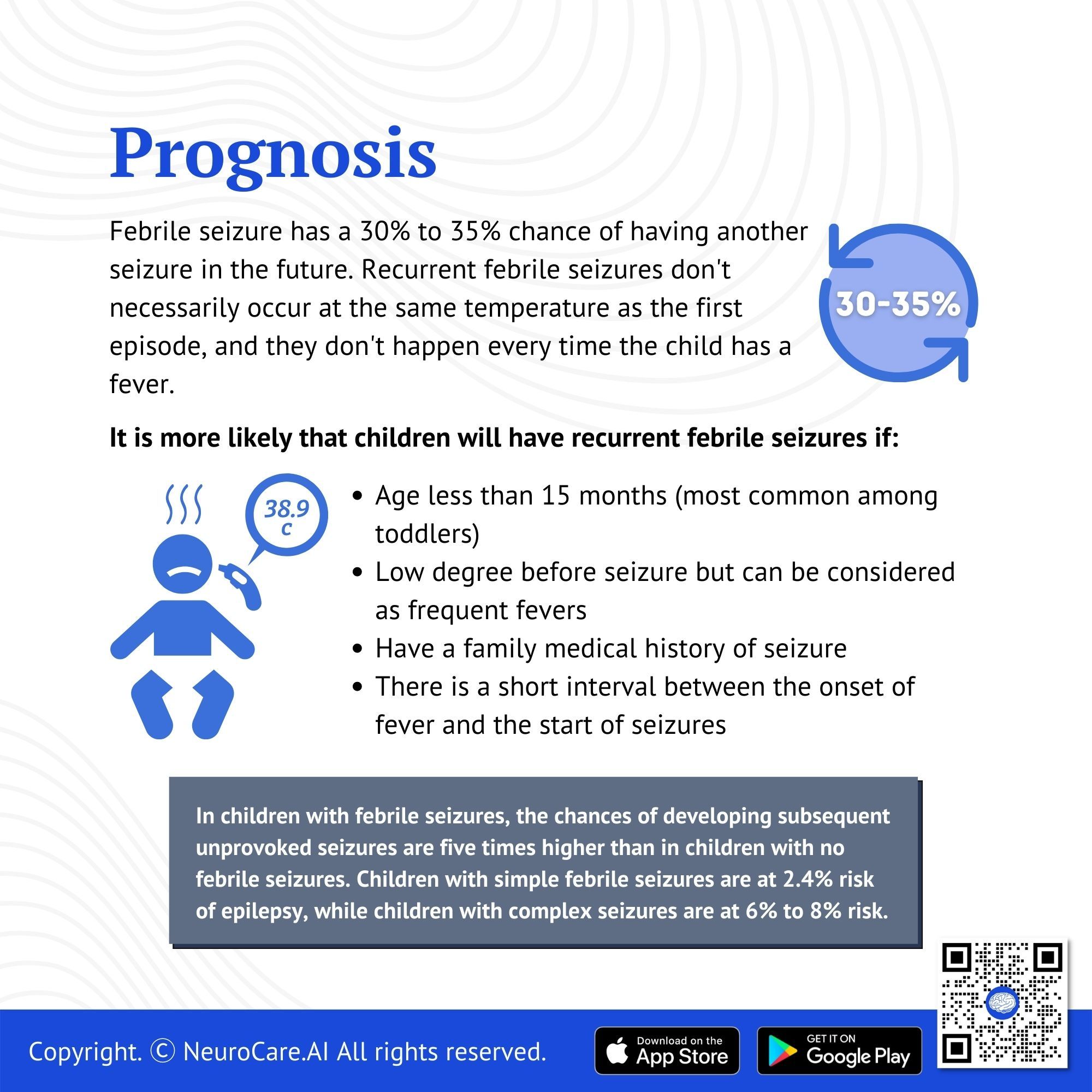
Prognosis
Febrile seizure has a 30% to 35% chance of having another seizure in the future. Recurrent febrile seizures don't necessarily occur at the same temperature as the first episode, and they don't happen every time the child has a fever. There are almost always recurrences within one year and most within two years of the first seizure.
It is more likely that children will have recurrent febrile seizures if:
- Age less than 15 months (most common among toddlers)
- Low degree before seizure but can be considered as frequent fevers
- Have a family medical history of seizure
- There is a short interval between the onset of fever and the start of seizures
A study reported that a recurrent febrile seizure poses a 33% risk to children with their first febrile seizure. In children with febrile seizures, the chances of developing subsequent unprovoked seizures are five times higher than in children with no febrile seizures. Children with simple febrile seizures are at 2.4% risk of epilepsy, while children with complex seizures are at 6% to 8% risk.
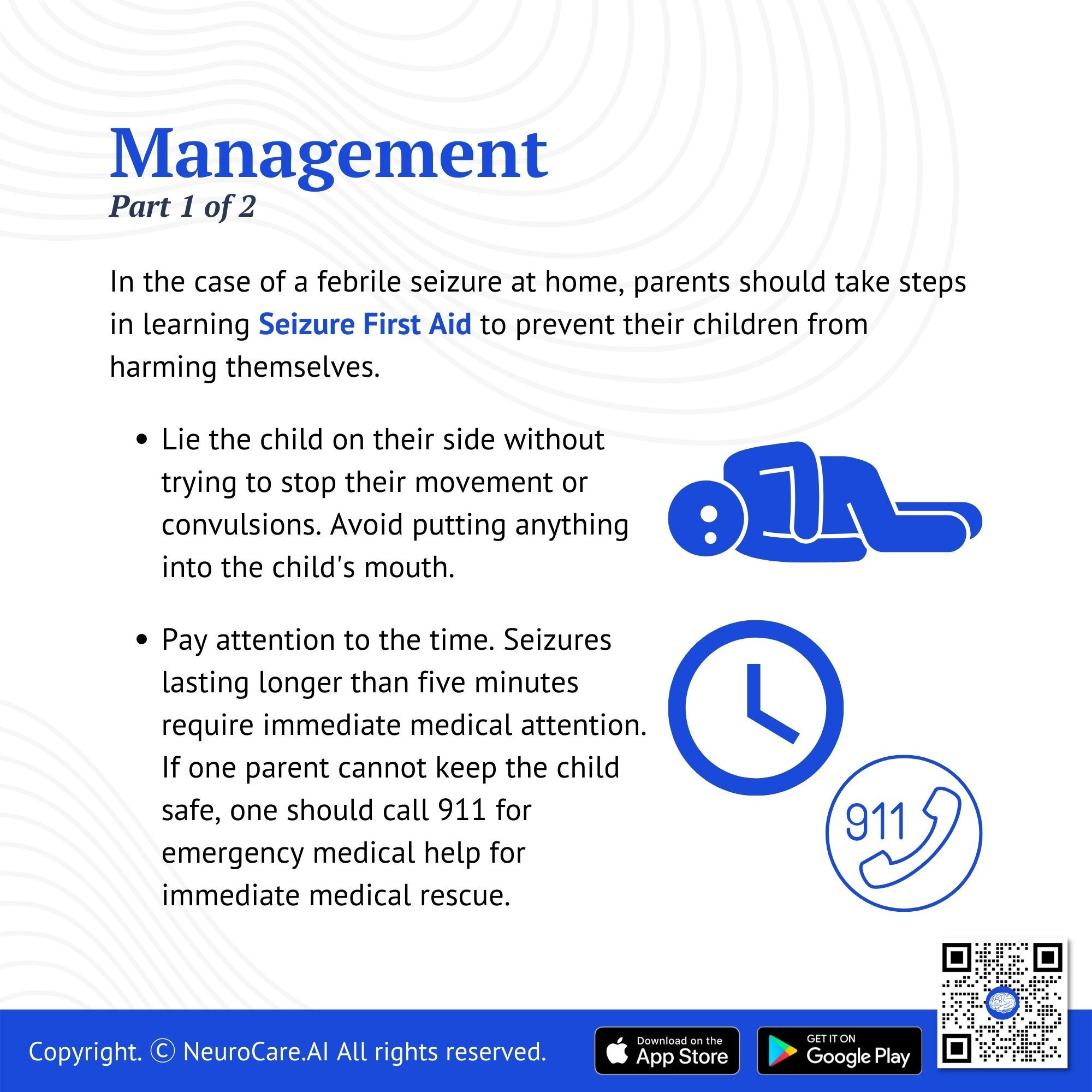
Management
In the case of a febrile seizure at home, parents should take steps in learning Seizure First Aid to prevent their children from harming themselves.
- Lie the child on their side without trying to stop their movement or convulsions. Avoid putting anything into the child's mouth.
- Pay attention to the time. Seizures lasting longer than five minutes require immediate medical attention. If one parent cannot keep the child safe, one should call 911 for emergency medical help for immediate medical rescue.
.jpg)
Emergency and prehospital management should stabilize the patient. Frequent febrile seizures are self-limited and disappear before the patient reaches the hospital. When seizures last longer than five minutes, they are unlikely to stop independently, so benzodiazepines should be administered to end the seizures.
Hospital admission is usually not necessary. Still, factors to consider include younger age, the need for further observation due to abnormal examination findings, or unreliable follow-up.
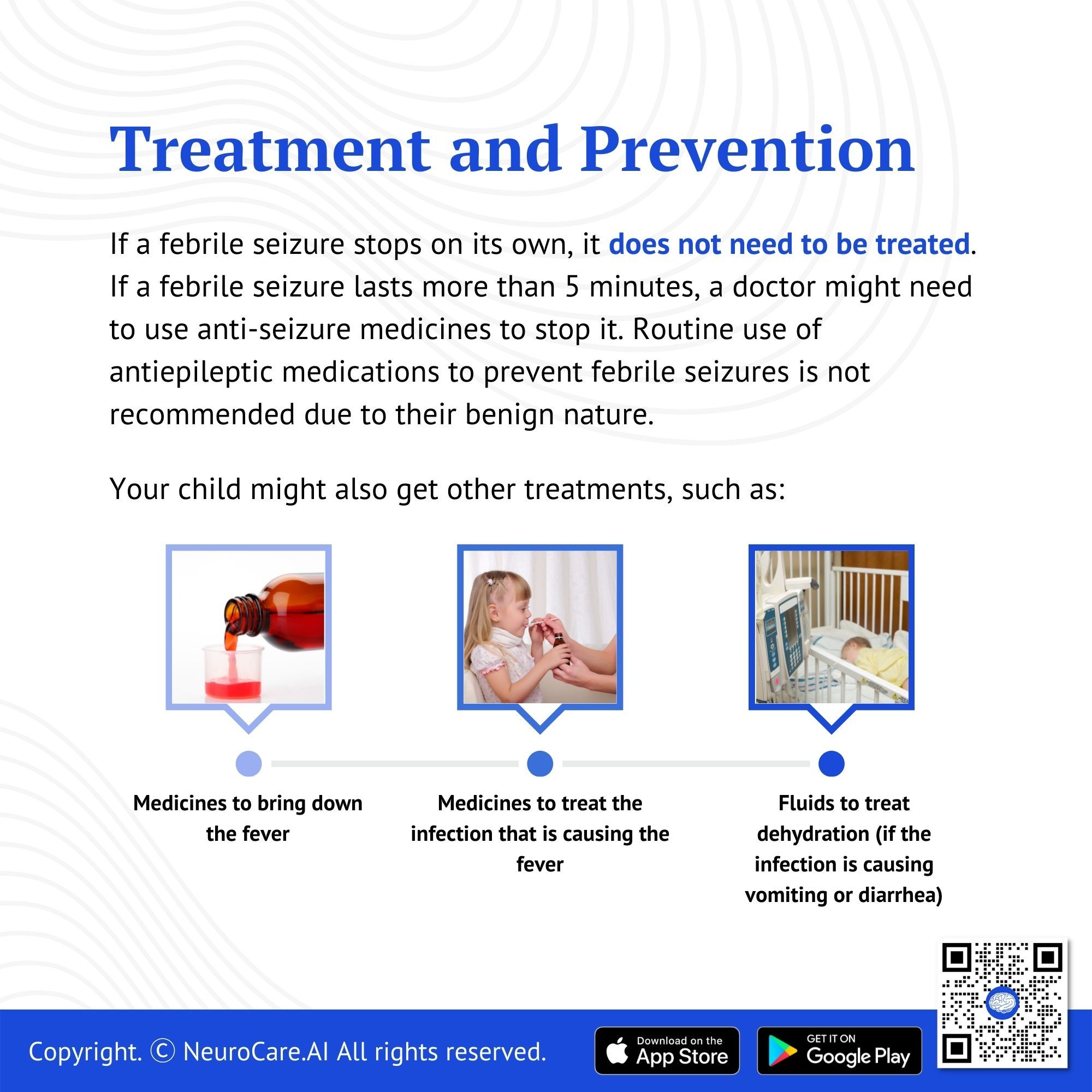
Treatment and prevention
If a febrile seizure stops on its own, it does not need to be treated. If a febrile seizure lasts more than 5 minutes, a doctor might need to use anti-seizure medicines to stop it.
Your child might also get other treatments, such as:
- Medicines to bring down the fever
- Medicines to treat the infection that is causing the fever
- Fluids to treat dehydration (if the infection is causing vomiting or diarrhea)
Numerous pharmacological interventions have been studied to prevent the recurrence of febrile seizures. Even though benzodiazepines or antiepileptics have significantly higher clinical and statistical benefits, adverse effects are experienced by 30% of most patients. Routine use of these medications to prevent febrile seizures is not recommended due to their benign nature. By attenuating the effects of the fever as a trigger, acetaminophen and ibuprofen are postulated to decrease the risk of febrile seizures.
Families of children at risk of having recurrent febrile seizures can learn how to treat them at home for seizures lasting more than five minutes. A single dose of diazepam gel is usually administered. The dosage is generally all that is needed to end a seizure.
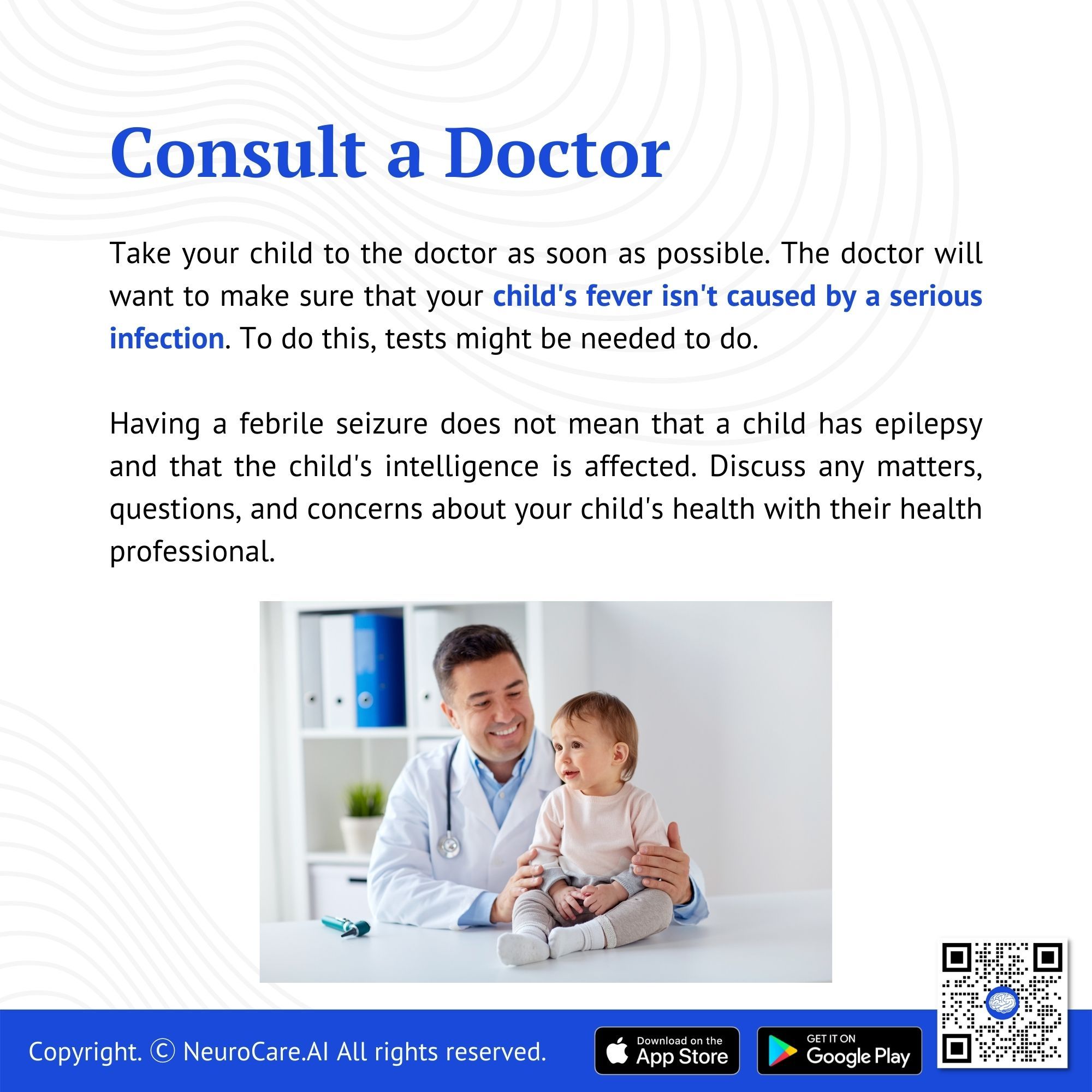
Consult a doctor
Take your child to the doctor as soon as possible. The doctor will want to make sure that your child's fever isn't caused by a serious infection. To do this, tests might be needed to do.
Having a febrile seizure does not mean that a child has epilepsy and that the child's intelligence is affected. Discuss any matters, questions, and concerns about your child's health with their health professional.
References:
- Smith DK, Sadler K, Benedum M. Febrile seizures: risks, evaluation, and prognosis. American family physician. 2019 Apr 1;99(7):445-50.
DISCLAIMER:
The information in this document is for general educational purposes only. It is not intended to substitute for personalized medical professional advice. NeuroCare.AI makes every effort to provide accurate and timely information, but makes no guarantee in this regard and disclaims responsibility for adverse consequences resulting from its use. For further information, consult a physician and the organization referred to herein.
AizaMD™: Revolutionizing Clinical Documentation
Discover the power of our ambient clinical documentation system, designed to transform clinical encounters into structured SOAP notes with unmatched ease. Experience exceptional value for less than $3 per day—cheaper than your daily coffee!
- Save Time: Free up over 90 minutes daily for each provider.
- Boost Revenue: Increase daily revenue by at least $1,000 per provider.
- Enhance Coding Quality: Our detailed documentation supports superior coding accuracy, ensuring optimal reimbursement.
- Maximize Engagement and Interaction: Dedicate more time to patient care and less to typing, fostering richer and more effective conversations between clinicians and patients
AizaMD™: Automated Radiology Report Generation!
Discover our breakthrough Radiology AI reporting platform built on Ambient AI. It enhances productivity and minimizes fatigue. Benefit from best-in-class accuracy with our automated radiology report generation, all at market-leading pricing.
📈 Efficiency: Cut dictation times by up to 50% (Less words, More report!
🎯 Focus: Keep your eyes on the images, not the keyboard!
💸 Revenue: Boost revenue by at least 20%
📑 Clarity: Patient summary in plain English
